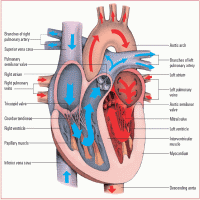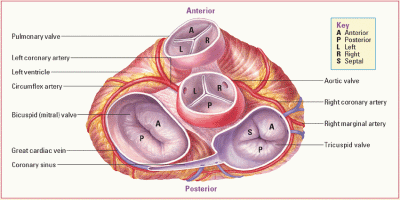Anatomy and Physiology
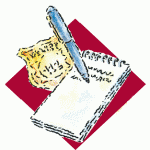 Just the facts
Just the factsIn this chapter, you’ll learn:
♦ components of the heart
♦ the way in which the heart contracts
♦ the heart’s role in blood flow.
A look at the cardiovascular system
The cardiovascular system (sometimes called the circulatory system) consists of the heart, blood vessels, and lymphatics. This network brings life-sustaining oxygen and nutrients to the body’s cells, removes metabolic waste products, and carries hormones from one part of the body to another.
Right to the lungs…and left to the body
The heart consists of two separate pumps: The right side pumps the blood to the lungs, and the left side pumps the blood to the rest of the body.
Where the heart lies
About the size of a closed fist, the heart lies beneath the sternum in the mediastinum (the cavity between the lungs), between the second and sixth ribs. In most people, the heart rests obliquely or tilted, with its right side below and almost in front of the left. Because of its oblique angle, the heart’s broad part (base) is at its upper right, and its pointed end (apex) is at its lower left. The apex, also called the PMI or point of maximal impulse, is where heart sounds can be heard the loudest.
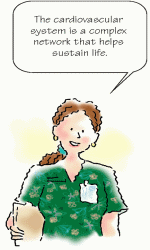 |
Heart structure
Surrounded by a sac called the pericardium, the heart has a wall made up of three layers: the endocardium (endo = inner), the myocardium (myo = middle), and the epicardium (epi = outer). Within the heart lie four chambers (two atria, a right side and a left side, and two ventricles, also a right side and a left side) and four valves (two atrioventricular [AV] and two semilunar valves). (See Inside the heart.)
The pericardium
The pericardium is a fibroserous sac that surrounds the heart and the roots of the great vessels (those vessels that enter and leave the heart). It consists of the fibrous pericardium and the serous pericardium.
Fibrous fits freely
The fibrous pericardium, composed of tough, white fibrous tissue, fits loosely around the heart, protecting it.
Serous is smooth
The serous pericardium, the thin, smooth inner portion, has two layers:
• The parietal layer lines the inside of the fibrous pericardium.
• The visceral layer adheres to the surface of the heart.
And fluid in between
Between the fibrous and serous pericardium is the pericardial space. This space contains pericardial fluid, which lubricates the surfaces of the space and allows the heart to move easily during contraction.
The wall
The wall of the heart consists of three layers:
 The epicardium, the outer layer (and the visceral layer of the serous pericardium), is made up of squamous epithelial cells overlying connective tissue.
The epicardium, the outer layer (and the visceral layer of the serous pericardium), is made up of squamous epithelial cells overlying connective tissue. The myocardium, the middle layer, forms most of the heart wall. It has striated muscle fibers that cause the heart to contract.
The myocardium, the middle layer, forms most of the heart wall. It has striated muscle fibers that cause the heart to contract. The endocardium, the heart’s inner layer, consists of endothelial tissue with small blood vessels and bundles of smooth muscle.
The endocardium, the heart’s inner layer, consists of endothelial tissue with small blood vessels and bundles of smooth muscle.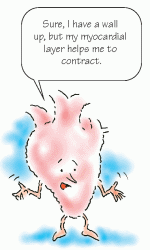 |
The chambers
The heart contains four hollow chambers: two atria and two ventricles.
Upstairs…
The atria, or upper chambers, are separated by the interatrial septum. They receive blood returning to the heart and pump blood to the ventricles, or lower chambers.
…where the blood comes in
The right atrium receives blood from the superior and inferior venae cavae. The left atrium, which is smaller but has thicker walls than the right atrium, forms the uppermost part of the heart’s left border. It receives blood from the two pulmonary veins.
Downstairs…
The right and left ventricles, which are separated by the interventricular septum, make up the two lower chambers. The ventricles receive blood from the atria. Composed of highly developed musculature, the ventricles are larger and have thicker walls than the atria.
…where the blood goes out
The right ventricle pumps blood to the lungs. The left ventricle, which is larger than the right, pumps blood through all other vessels of the body.
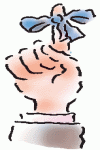 Memory jogger
Memory joggerIf you can remember that there are two distinct heart sounds, you can recall that there are two sets of heart valves. Closure of these valves produces the heart sounds frequently known as the “lub-dub.” The first heart sound is created when the atrioventricular (AV) valves close. Again, this valvular closure makes the first heart sound, the lub. Closure of the semilunar (SL) valves produces the second heart sound, the dub.
The valves
The heart contains four valves: two AV valves and two semilunar valves.
Forward flow only
The valves allow forward flow of blood through the heart and prevent backward flow, or regurgitation. The valves open and close in response to pressure changes caused by ventricular contraction and blood ejection. The two AV valves separate the atria from the ventricles. The tricuspid valve, or right AV valve, prevents backflow from the right ventricle into the right atrium. The mitral valve, or left AV valve, prevents backflow from the left ventricle into the left atrium. One of the two semilunar valves is the pulmonic valve, which prevents backflow from the pulmonary artery into the right ventricle. The other semilunar valve is the aortic valve, which prevents backflow from the aorta into the left ventricle.
On the cusps
The tricuspid valve has three triangular cusps, or leaflets. The mitral, or bicuspid, valve contains two cusps, a large anterior and a smaller posterior. Chordae tendineae (tendinous cords) attach the cusps of the AV valves to papillary muscles in the ventricles. The semilunar valves have three cusps that are shaped like half-moons. (See Heart valves.)
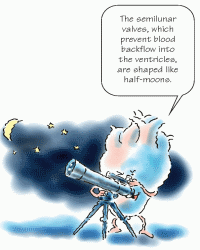 |
Conduction system
The heart’s conduction system causes it to contract, moving blood throughout the body. For this system to work properly, the heart requires electrical stimulation as well as a mechanical response. (See The cardiac conduction system, page 6.)
Electrical stimulation
The conduction system contains pacemaker cells, which have three unique characteristics:
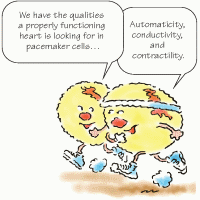 |
Stay updated, free articles. Join our Telegram channel

Full access? Get Clinical Tree


